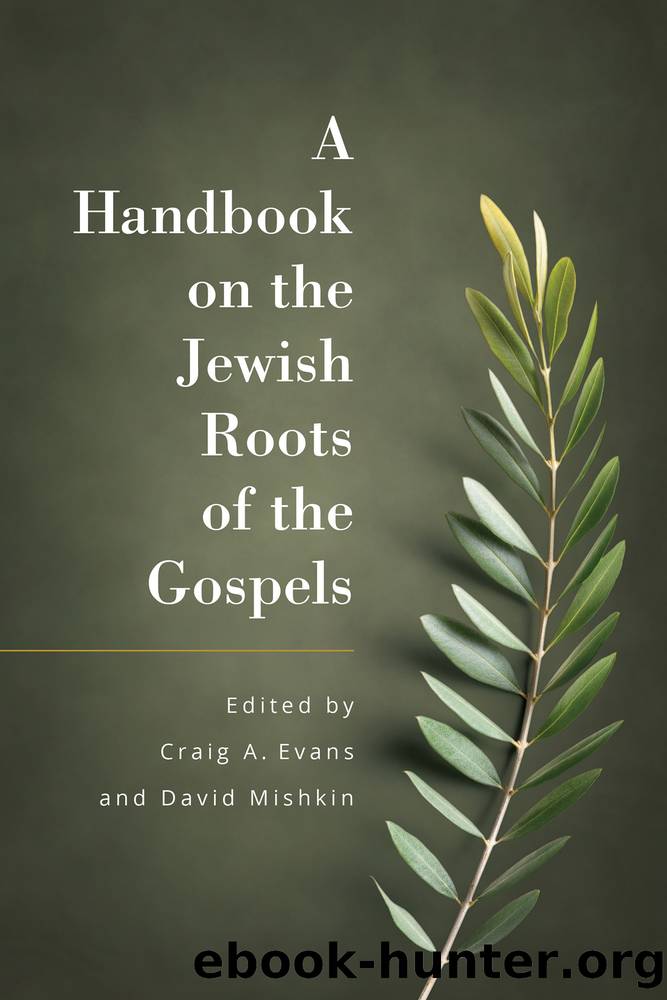A Handbook on the Jewish Roots of the Gospels by Craig Evans

Author:Craig Evans
Language: eng
Format: epub
Tags: Religion, Biblical Studies, New Testament, Jesus, the Gospels & Acts
ISBN: 9781496465863
Publisher: Hendrickson Publishers
3.7 Jesus and Women in the Gospels
Sisi Soref
The four canonical Gospels portray the life and ministry of Jesus as offering a unique place to women, and an honored one at that. The exact role of women in the world of Second Temple Judaism, and the extent to which Jesusâ interactions were unique, has certainly been debated (Levine 1991; Kitzberger 2000). But Jesusâ relationship to women is noteworthy first of all because of the volume and diversity of examples. From start to finish, the evangelists include women in the story. At the beginning, there is Anna, who is described as among the righteous remnant waiting for the Messiah and who is specifically described as a prophetess (Luke 2:36â38). At the end, all four Gospels record that the Jesus movement began with the proclamation by women that his tomb was empty (Matt 28:5â8; Mark 16:1â6; Luke 24:1â11; John 20:1â17). He had female disciples (Matt 27:55, Luke 8:3). This in itself may not be unprecedented in the ancient world (Ilan 2017), but the prominence of women mentioned in connection to this one particular rabbi is in fact unique. As a healer, he transformed the lives of women who were suffering from evil spirits (Matt 15:22â28; Luke 8:2; 13:11), physical infirmities (Mark 5:27â34; Luke 4:38), and spiritual dilemmas (John 4:4â26; 8:3â11). He praised women for their faith (Mark 12:43â44 // Luke 21:1â4), included women as examples in his parables (Matt 25:1â13; Luke 15:8â10; 18:1â8), and pronounced their sins forgiven (Luke 7:48; John 8:11). These encounters are not incidental to the narrative, they are a foundational part of the life and message of Jesus.
It is also interesting to note that the Gospels do not include examples of Jesus speaking negatively or derogatively against women. One possible exception is how he spoke to his mother in John 2:4: âWoman, what concern is that to you and me? My hour has not yet comeâ (NRSV). But when the language in this verse (specifically the use of the word woman, which sounds odd in English) is compared with the use of the same word in John 19:26â27 (when Jesus was on the cross and yet making plans to care for her), it becomes difficult to accuse him of misogyny. Likewise, Matt 10:34â37 and Luke 12:51â53 should be seen as hyperbolic warnings of the potential consequences of a radical commitment to following Jesus as Messiah and not as negative statements. His teachings on divorce (Matt 19:3â10; Mark 10:2â12) are more complicated and go beyond the discussion here, but modern commentators need to take into account both the historical and legal factors of the day (see Instone-Brewer 2002; Satlow 2017), as well as the way in which Jesus is presented throughout the Gospels.
In this article, I will argue that the specific places where women are mentioned bear a specific meaning that the author intends to communicate. Further, I will attempt to demonstrate that understanding this context is paramount to understanding the value Jesus placed on women, which leads to lessons that are applicable to all.
Download
This site does not store any files on its server. We only index and link to content provided by other sites. Please contact the content providers to delete copyright contents if any and email us, we'll remove relevant links or contents immediately.
| Baha'i | Cults |
| Demonology & Satanism | Eckankar |
| Egyptian Book of the Dead | Freemasonry |
| Messianic Judaism | Mysticism |
| Scientology | Theism |
| Tribal & Ethnic | Unitarian Universalism |
The Four Agreements by Don Miguel Ruiz(6618)
Breaking Free by Rachel Jeffs(4174)
The Hatha Yoga Pradipika (Translated) by Svatmarama(3227)
120 Days of Sodom by Marquis de Sade(3176)
Member of the Family by Dianne Lake(2302)
The Tao of Physics by Fritjof Capra(2227)
The Psychedelic Gospels: The Secret History of Hallucinogens in Christianity by Jerry B. Brown(2120)
The Road to Jonestown by Jeff Guinn(2019)
Going Clear: Scientology, Hollywood, and the Prison of Belief by Lawrence Wright(1935)
Going Clear by Lawrence Wright(1921)
Uriel's Machine by Christopher Knight(1862)
The Grand Grimoire: The Red Dragon by Author Unknown(1757)
The Gnostic Gospel of St. Thomas by Tau Malachi(1736)
Key to the Sacred Pattern: The Untold Story of Rennes-le-Chateau by Henry Lincoln(1592)
The Malloreon: Book 02 - King of the Murgos by David Eddings(1554)
Waco by David Thibodeau & Leon Whiteson & Aviva Layton(1530)
The New World Order Book by Nick Redfern(1525)
Animal Speak by Ted Andrews(1513)
The Secret of the Temple by John Michael Greer(1462)
